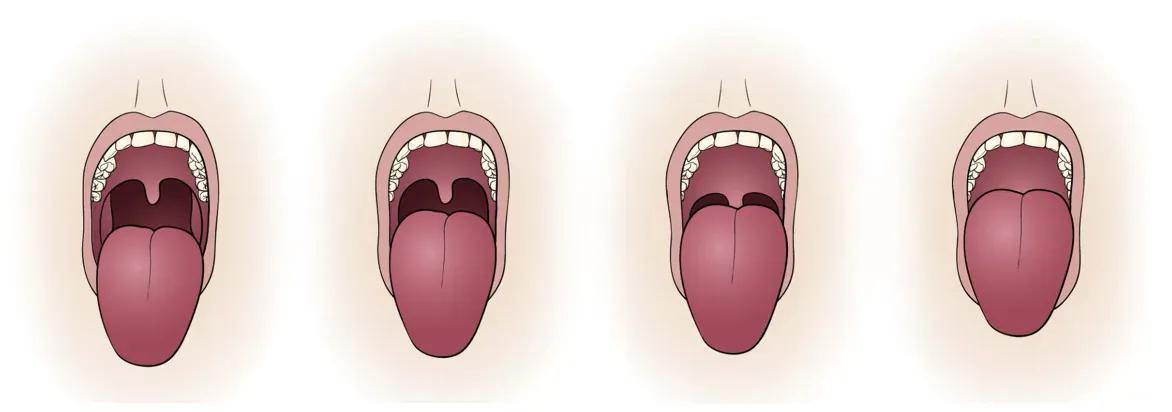Tongue Tie in Adults

What is an Adult Tongue Tie?
An adult tongue tie, medically known as ankyloglossia, is a condition where the lingual frenulum (the tissue connecting the tongue to the floor of the mouth) is unusually short or tight. This restriction can limit tongue movement, causing various health and functional issues.
Is a Tongue Tie Just a Baby's Issue?
No, it is not. Many people are aware that a tongue tie can cause newborn babies problems with breastfeeding. However, not many know that if a tongue tie is not corrected in childhood, it can cause various issues in adults as well.
A tongue tie that is not corrected can lead to the growth of a narrow upper jaw, breathing problems, orthodontic issues, and posture problems such as scoliosis. It causes the tongue to rest toward the back of the mouth, contributing to airway obstruction. This can result in snoring, teeth grinding and clenching, sleep apnea, receding gums, and TMJ issues.
How can I find if my tongue is tied?
- You can check if you are tongue tied yourself.
- When you look under your tongue as you lift the tip of it up, you will notice a tag of tissues right in the middle connecting the tongue to the bottom of your mouth. This is a tongue frenulum.
- Try to open your mouth to the full extent and lift the tongue up at the same time. The tip of the tongue should touch or almost touch the roof of the mouth. If you cannot lift it up even half way, if the tip of the tongue is developing a notch splitting the tip in two, there are high chances your tongue is tied to the bottom of the mouth.
- Now you can try to stick your tongue out - if you can reach to the lower border of your nose and to the middle of your chin then your tongue has enough flexibility and most probably functions well. If you barely could get the tip of the tongue out to touch above or below the lip then your tongue is not flexible enough.
- In addition, you can open your mouth wide and look in the mirror at the back of it. If the look of your mouth resembles the pictures on the left it often means that your tongue has the wrong position, possibly indicating tongue tie, and it is obstructing the airway and causing lack of oxygen for the body.
What do I need to do if I suspect my tongue to be tied?
If the tongue is not stretching enough the anatomy of your tongue and function needs to be assessed by a dentist.
At Blue Heron Dental Center (London, Ontario), Dr. Yurchuk can assess your tongue positions and conditions of upper airways. She will suggest how to manage the condition. In cases when tongue tie is combined with sleeping apnea, TMJ problems, throat or ear infection you could be referred to the specialists.
What can be done if I have a tongue tie?
Depending on your age, the severity of the tongue tie, and what other issues it is causing, your dentist Dr. Alena Yurchuk could suggest a combination of the following approaches:
- Myofunctional therapy combining exercises and massage. Gymnastics to your tongue muscle and other muscles suffering from the wrong tongue position could help to
- Surgical correction, which is a quick laser procedure or a classic surgical procedure.
- Orthodontic treatment to expand jaw space for your depressed tongue.
- Night guard to protect your teeth from grinding and clenching
- Referral to sleep specialist, myofunctional therapist
Groups of exercises for neck, jaw and bottom of the mouth.
Tongue tie is often combined with increased muscle tone in your neck, the bottom of the mouth and actual tongue muscles.
These muscles are becoming stiff and not stretching enough to function. This reduces the ability to move your tongue, jaw and neck well. Exercises are recommended in order to increase a range of motions through stretches. As you are repeating exercises, your muscles are elongating, becoming less tendon and allowing movements to be more free.
When doing exercises pay attention to these recommendations:
- If general health conditions could be affected by the exercises, consult with your MD and a dentist before starting them.
- Do not force movements, move gently and slowly.
- It should not be any pain when you exercise. Feeling a stretch though is fine.
- Keep breathing through all exercises: focus on taking deep breaths, breath slowly in and out.
- The key of success with stretching is to allow some time for the fibers to actually stretch. Start slowly with holding each stretch for 20-30 seconds and gradually increase time. You would need to hold a stretch for 1-2 minutes eventually.
1. Neck Extension
- Sit up tall in a chair, face forward.
- Tilt your head upwards, looking up towards the ceiling.
- Keep the chin tilted up as far as you can, without pain.
- Hold stretch for 5 breaths.
- Repeat this exercise 10 times.
2. Neck Rotation
- Sit up tall in a chair, face forward.
- Turn your head to the right, looking over your shoulder as far as you can without pain.
- Hold for 5 breaths.
- Turn your head to the left, looking over your shoulder as far as you can without pain.
- Hold for 5 breaths.
- Repeat this exercise 10 times.
3. Neck Flexion
- Sit up tall in a chair, face forward.
- Slowly tilt your head to the right, bringing right ear to right shoulder.
- Keep your face looking forward the entire time.
- Hold for 5 breaths.
- Return to start position.
- Slowly tilt your head to the left, bringing left ear to left shoulder.
- Keep your face looking forward the entire time.
- Hold for 5 breaths.
- It is okay if your ear does not actually reach/touch your shoulder.
- Repeat this exercise 10 times.
4. Jaw Opening
- Sit up tall in a chair, face forward.
- Gently open your mouth as wide as you can, without pain.
- Hold this stretch for 5 breaths.
- Relax the jaw.
- Repeat this exercise 10 times.
5. Shoulder Shrugs - “ear to shoulder”
- Sit up tall in a chair, face forward.
- Bring both shoulders up towards your ears. Try to keep the shoulders even.
- Hold for 5 breaths.
- Relax.
- Repeat this exercise 10 times.
6. Arm Raises
- Stand up tall, face forward.
- Put your arms by your sides, palms facing forward.
- Raise your arms slowly until you feel a stretch in your shoulders or neck.
- Try to keep your arms even.
- Hold for 5 breaths.
- Repeat this exercise 10 times.
In case of a low posture of the tongue and a tongue tie, exercises for the tongue and muscles of the bottom of the mouth will be beneficial as well. Dr. Alena Yurchuk and the team of hygienists could demonstrate techniques and track the results of the myofunctional therapy.

Please CALL US the Blue Heron Dental office if you have questions.
